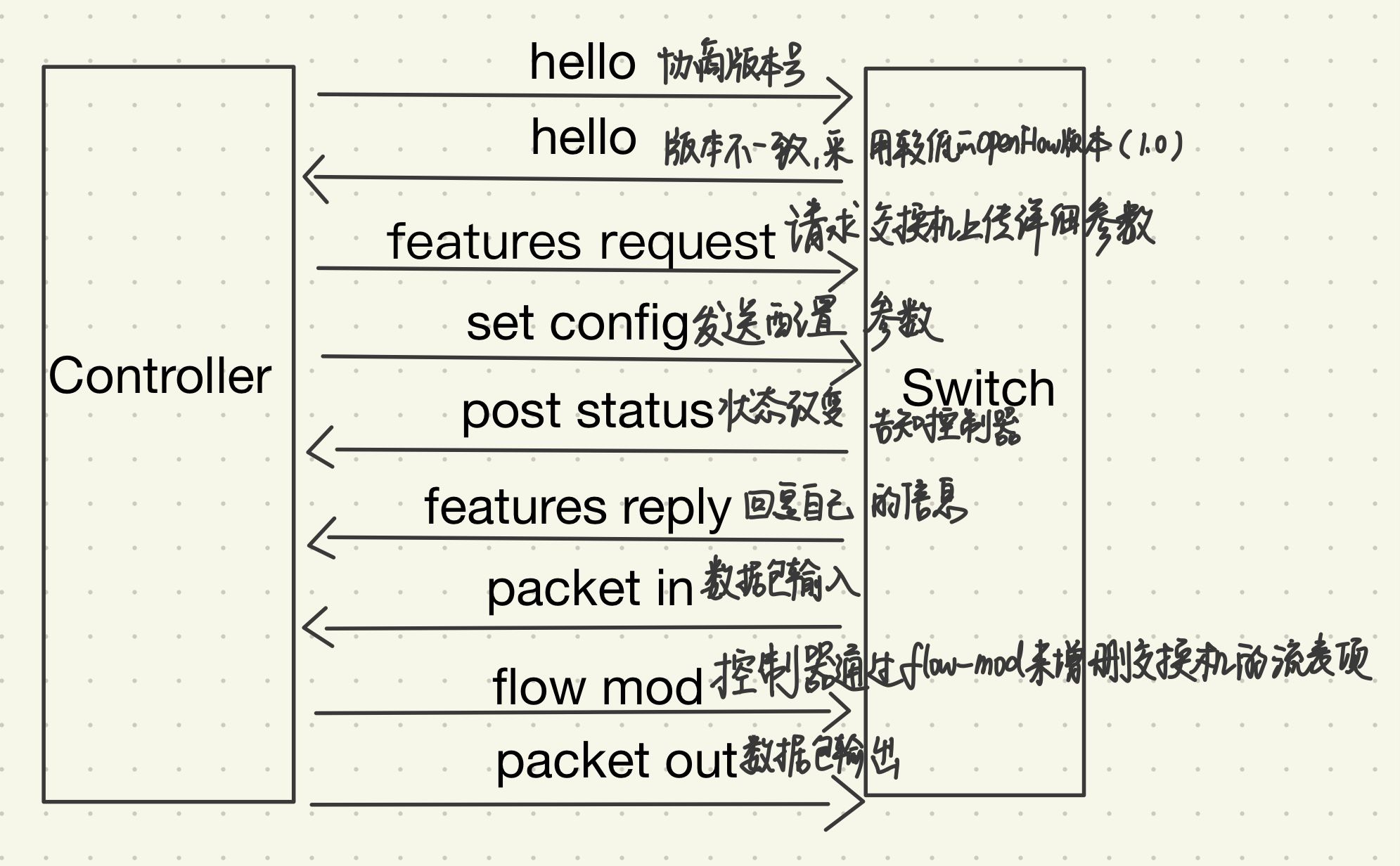实验3:OpenFlow协议分析实践
一、实验目的
能够运用 wireshark 对 OpenFlow 协议数据交互过程进行抓包;
能够借助包解析工具,分析与解释 OpenFlow协议的数据包交互过程与机制。
二、实验环境
Ubuntu 20.04 Desktop amd64
三、实验要求
(一)基本要求
1.搭建下图所示拓扑,完成相关 IP 配置,并实现主机与主机之间的 IP 通信。
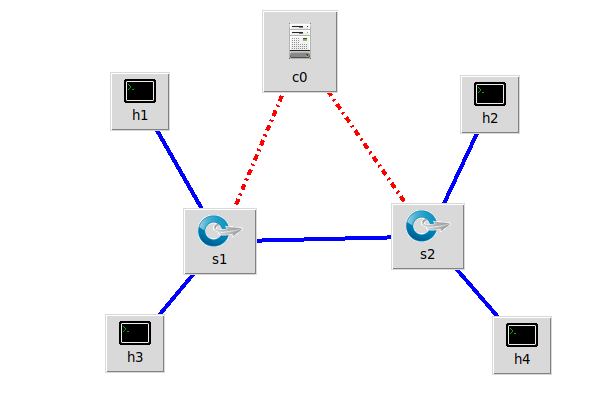
拓扑文件
from mininet.net import Mininet
from mininet.node import Controller, RemoteController, OVSController
from mininet.node import CPULimitedHost, Host, Node
from mininet.node import OVSKernelSwitch, UserSwitch
from mininet.node import IVSSwitch
from mininet.cli import CLI
from mininet.log import setLogLevel, info
from mininet.link import TCLink, Intf
from subprocess import call
def myNetwork():
net = Mininet( topo=None,
build=False,
ipBase='192.168.0.0/24')
info( '*** Adding controller\n' )
c0=net.addController(name='c0',
controller=Controller,
protocol='tcp',
port=6633)
info( '*** Add switches\n')
s1 = net.addSwitch('s1', cls=OVSKernelSwitch)
s2 = net.addSwitch('s2', cls=OVSKernelSwitch)
info( '*** Add hosts\n')
h1 = net.addHost('h1', cls=Host, ip='192.168.0.101/24', defaultRoute=None)
h2 = net.addHost('h2', cls=Host, ip='192.168.0.102/24', defaultRoute=None)
h3 = net.addHost('h3', cls=Host, ip='192.168.0.103/24', defaultRoute=None)
h4 = net.addHost('h4', cls=Host, ip='192.168.0.104/24', defaultRoute=None)
info( '*** Add links\n')
net.addLink(h1, s1)
net.addLink(s1, h3)
net.addLink(s1, s2)
net.addLink(s2, h2)
net.addLink(s2, h4)
info( '*** Starting network\n')
net.build()
info( '*** Starting controllers\n')
for controller in net.controllers:
controller.start()
info( '*** Starting switches\n')
net.get('s1').start([c0])
net.get('s2').start([c0])
info( '*** Post configure switches and hosts\n')
CLI(net)
net.stop()
if __name__ == '__main__':
setLogLevel( 'info' )
myNetwork()
用抓包软件获取控制器与交换机之间的通信数据。
1.Hello
控制器6633端口(我最高能支持OpenFlow 1.0) ---> 交换45528机端口

交换机45528端口(我最高能支持OpenFlow 1.5) ---> 控制器6633端口
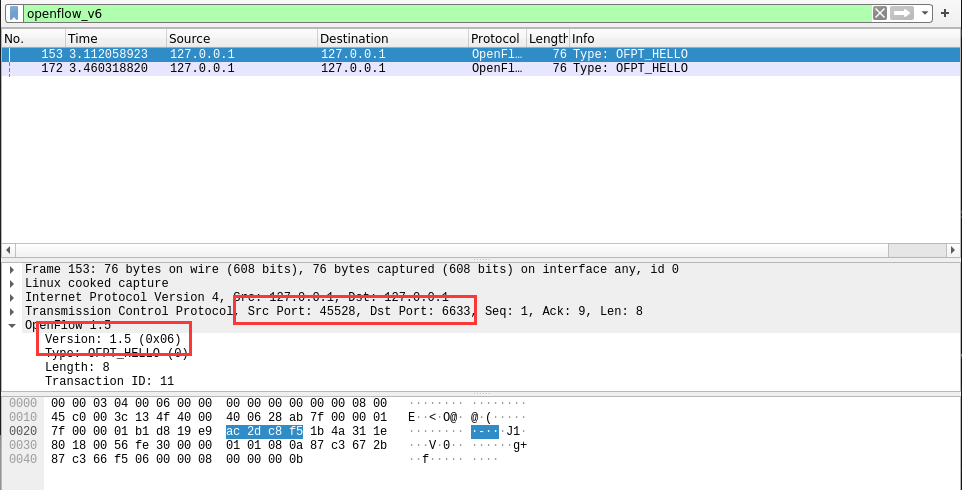
2.Features Request
控制器6633端口(我需要你的特征信息) ---> 交换机45528端口
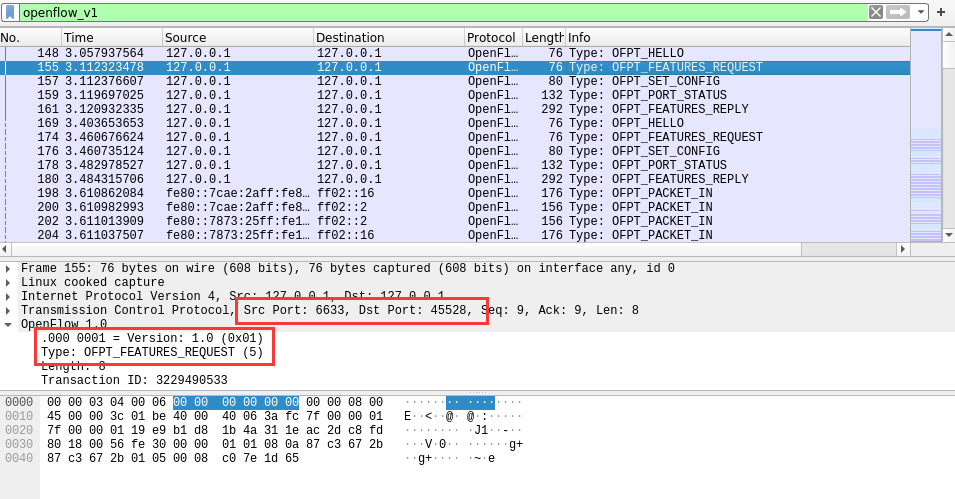
3.Set Config
控制器6633端口(请按照我给你的flag和max bytes of packet进行配置) ---> 交换机45528端口
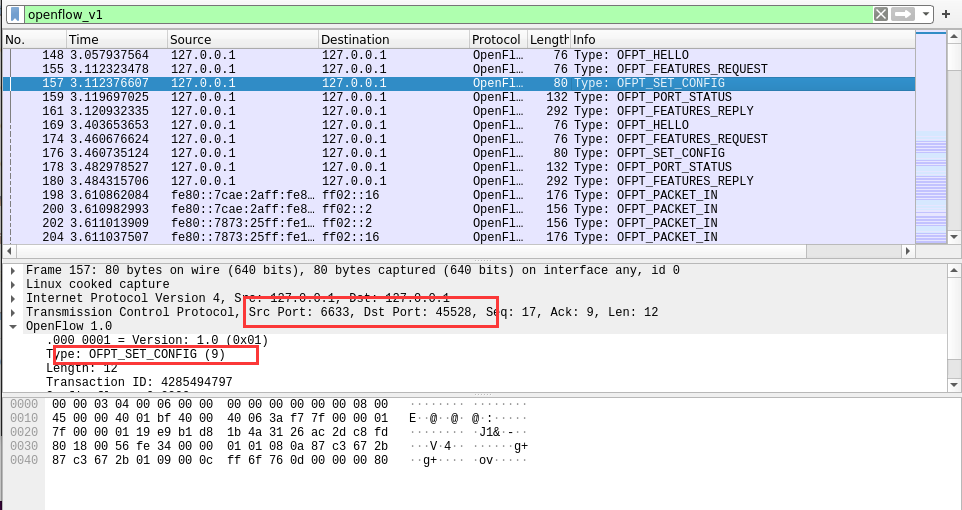
4.Port_Status
当交换机端口发生变化时,告知控制器相应的端口状态。
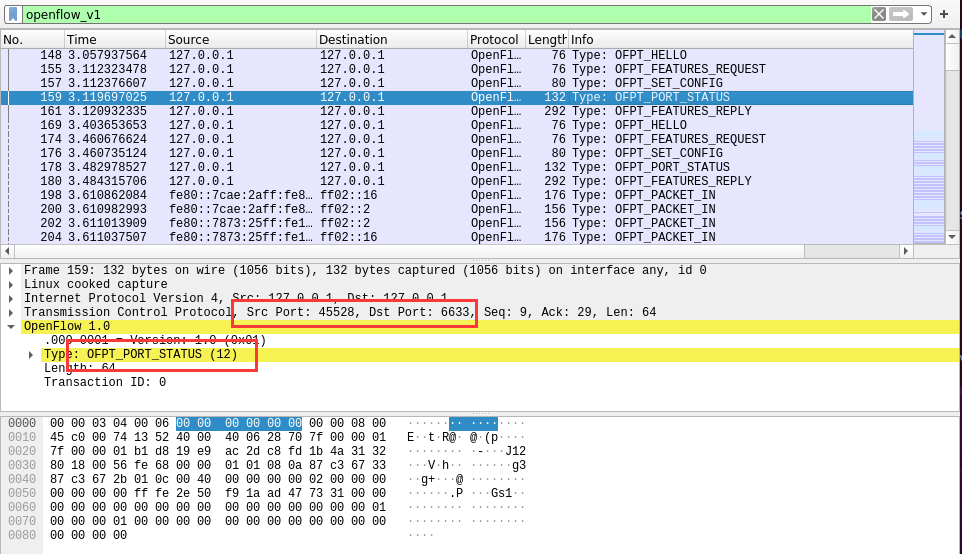
5.Features Reply
交换机45528端口(这是我的特征信息,请查收) ---> 控制器6633端口
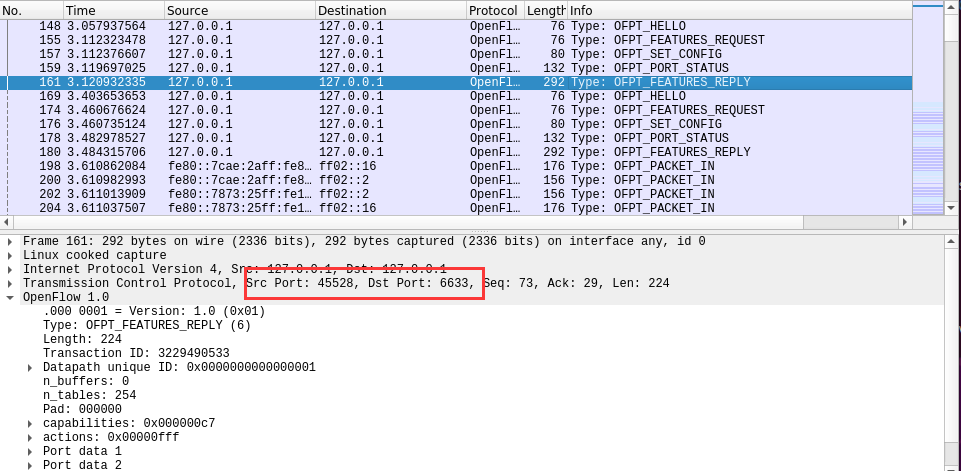
6.Packet_in
有两种情况: • 交换机查找流表,发现没有匹配条目时
• 有匹配条目但是对应的action是OUTPUT=CONTROLLER时
交换机45528端口(有数据包进来,请指示)--- 控制器6633端口
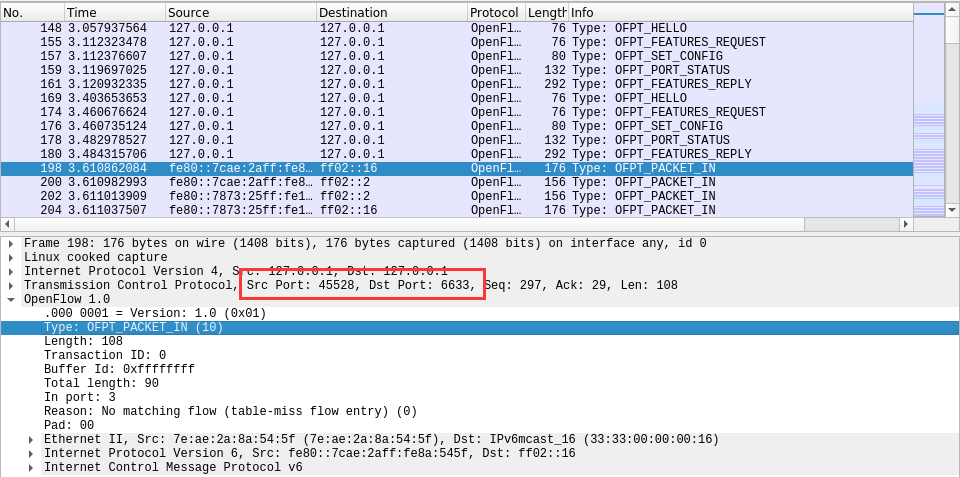
7.Flow_mod
分析抓取的flow_mod数据包,控制器通过6633端口向交换机45528端口下发流表项,指导数据的转发处理
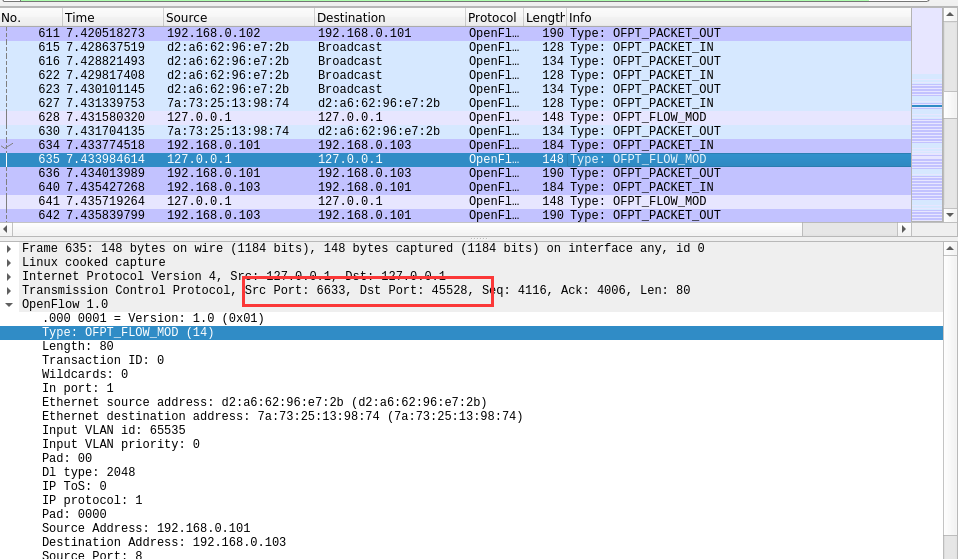

8.Packet_out
控制器6633端口(请按照我给你的action进行处理) ---> 交换机45528端口
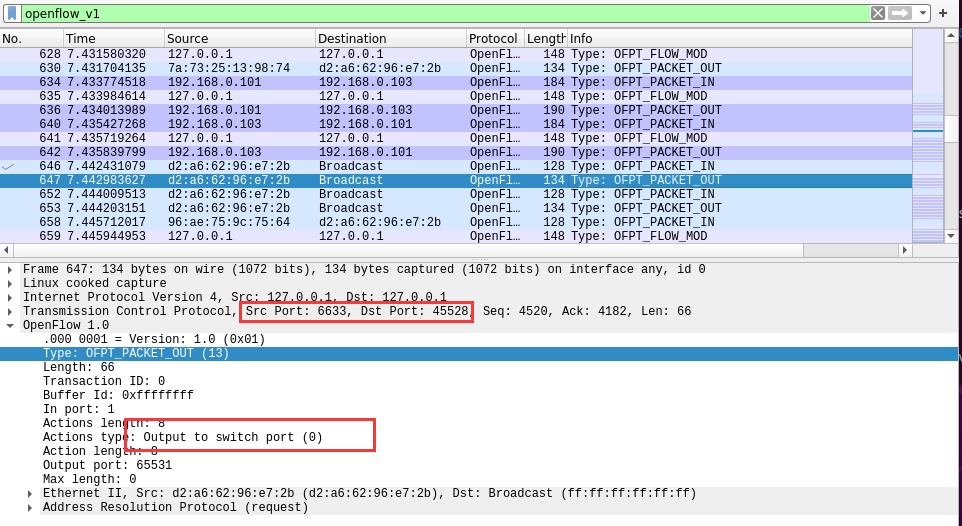
查看抓包结果,分析OpenFlow协议中交换机与控制器的消息交互过程,画出相关交互图或流程图。
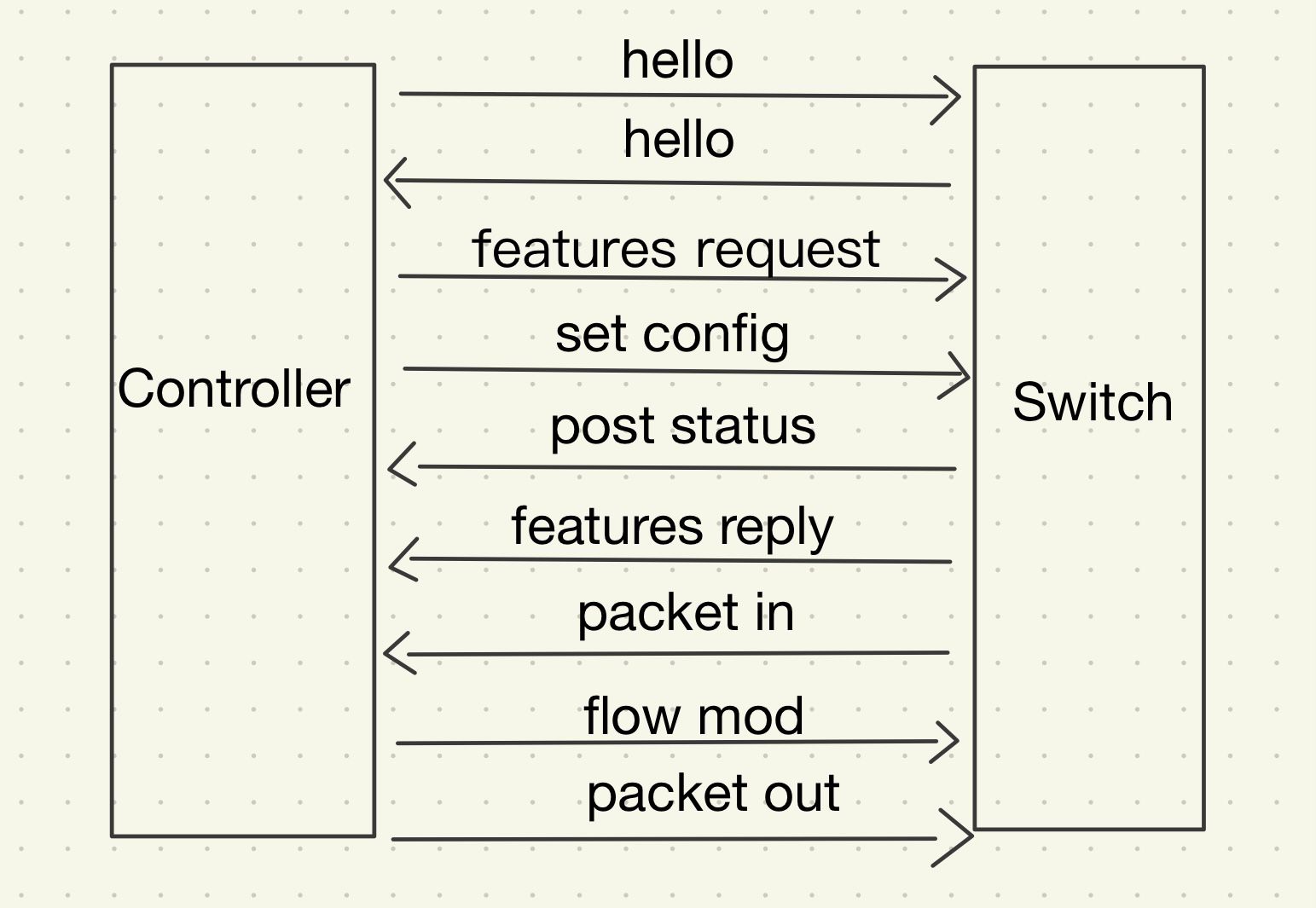
回答问题:交换机与控制器建立通信时是使用TCP协议还是UDP协议?
TCP协议
(二)进阶要求
将抓包基础要求第2步的抓包结果对照OpenFlow源码,了解OpenFlow主要消息类型对应的数据结构定义。
1.Hello
struct ofp_header {
uint8_t version; /* OFP_VERSION. */
uint8_t type; /* One of the OFPT_ constants. */
uint16_t length; /* Length including this ofp_header. */
uint32_t xid;
/* Transaction id associated with this packet.
Replies use the same id as was in the request to facilitate pairing.
*/};
struct ofp_hello {
struct ofp_header header;
};

2.Features Request

3.Set Config
struct ofp_switch_config
{
struct ofp_header header;
uint16_t flags; /* OFPC_* flags. */
uint16_t miss_send_len; /* Max bytes of new flow that datapath should
send to the controller. */
};

4.Port_Status
/* A physical port has changed in the datapath */
struct ofp_port_status {
struct ofp_header header;
uint8_t reason; /* One of OFPPR_*. */
uint8_t pad[7]; /* Align to 64-bits. */
struct ofp_phy_port desc;
};

5.Features Reply
struct ofp_switch_features {
struct ofp_header header;
uint64_t datapath_id;
/* Datapath unique ID. The lower 48-bits are for a MAC address, while the upper 16-bits are implementer-defined. */
uint32_t n_buffers; /* Max packets buffered at once. */
uint8_t n_tables; /* Number of tables supported by datapath. */
uint8_t pad[3]; /* Align to 64-bits. */ /* Features. */
uint32_t capabilities; /* Bitmap of support "ofp_capabilities". */
uint32_t actions; /* Bitmap of supported "ofp_action_type"s. */ /* Port info.*/
struct ofp_phy_port ports[0]; /* Port definitions. The number of ports is inferred from the length field in the header. */};
/* Description of a physical port */
struct ofp_phy_port {
uint16_t port_no;
uint8_t hw_addr[OFP_ETH_ALEN];
char name[OFP_MAX_PORT_NAME_LEN]; /* Null-terminated */
uint32_t config; /* Bitmap of OFPPC_* flags. */
uint32_t state; /* Bitmap of OFPPS_* flags. */
/* Bitmaps of OFPPF_* that describe features. All bits zeroed if * unsupported or unavailable. */
uint32_t curr; /* Current features. */
uint32_t advertised; /* Features being advertised by the port. */
uint32_t supported; /* Features supported by the port. */
uint32_t peer; /* Features advertised by peer. */
};

6.Packet_in
struct ofp_packet_in
{
struct ofp_header header;
uint32_t buffer_id; /* ID assigned by datapath. */
uint16_t total_len; /* Full length of frame. */
uint16_t in_port; /* Port on which frame was received. */
uint8_t reason; /* Reason packet is being sent (one of OFPR_*) */
uint8_t pad;
uint8_t data[0]; /* Ethernet frame, halfway through 32-bit word,
so the IP header is 32-bit aligned. The
amount of data is inferred from the length
field in the header. Because of padding,
offsetof(struct ofp_packet_in, data) ==
sizeof(struct ofp_packet_in) - 2. */
};

7.Flow_mod
/* Flow setup and teardown (controller -> datapath). */
struct ofp_flow_mod {
struct ofp_header header;
struct ofp_match match; /* Fields to match */
uint64_t cookie; /* Opaque controller-issued identifier. */
/* Flow actions. */
uint16_t command; /* One of OFPFC_*. */
uint16_t idle_timeout; /* Idle time before discarding (seconds). */
uint16_t hard_timeout; /* Max time before discarding (seconds). */
uint16_t priority; /* Priority level of flow entry. */
uint32_t buffer_id; /* Buffered packet to apply to (or -1).
Not meaningful for OFPFC_DELETE*. */
uint16_t out_port; /* For OFPFC_DELETE* commands, require
matching entries to include this as an
output port. A value of OFPP_NONE
indicates no restriction. */
uint16_t flags; /* One of OFPFF_*. */
struct ofp_action_header actions[0]; /* The action length is inferred
from the length field in the
header. */
};

8.Packet_out
/* Send packet (controller -> datapath). */
struct ofp_packet_out
{
struct ofp_header header;
uint32_t buffer_id; /* ID assigned by datapath (-1 if none). */
uint16_t in_port; /* Packet's input port (OFPP_NONE if none). */
uint16_t actions_len; /* Size of action array in bytes. */
struct ofp_action_header actions[0]; /* Actions. */
/* uint8_t data[0]; */ /* Packet data. The length is inferred
from the length field in the header.
(Only meaningful if buffer_id == -1.) */
};

(三)个人总结
心得
总的来说本次实验的难度不大,完成下来也比较顺利,主要就是考验耐心,但是还是有很多值得注意的细节!!!!
- 构建拓扑结构时要注意在“Edit”中选择“Preferences”,进入界面并修改IP Base的值
- 抓包:要先打开wireshark再构建拓扑
- 掌握了Wireshark的使用方法,深入学习了OpenFlow协议中数据包的流动
- 截图的时候要先过滤出我们要的数据包哦
对OpenFlow协议消息的学习
